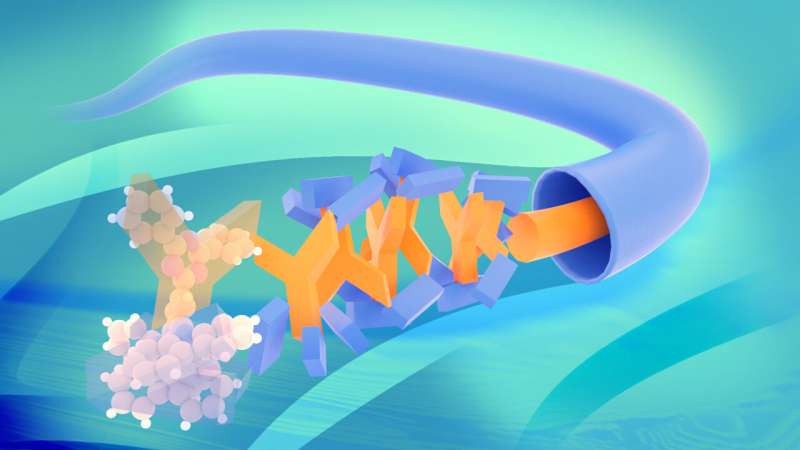
Due to the special chemical structure, the molecules arrange themselves in a kind of spiral. The result: The electron-conducting core is protected, which leads to a higher efficiency of the organic light-emitting diode. Source: MPI-P
Organic light-emitting diodes (OLEDs) are widely used today. For use in displays, blue OLEDs are needed to complement the primary colors red and green. Especially in blue OLEDs, impurities produce strong electrical losses, which can be partly avoided by using more complex and expensive device layouts. A team from the Max Planck Institute for Polymer Research has now developed a new material concept that could potentially allow efficient blue OLEDs with a robust simplified structure.
From televisions to smartphones: organic light-emitting diodes (OLEDs) are now finding their way into many of the devices we use every day. To display an image, they need the three primary colors red, green and blue. In particular, light-emitting diodes for blue light are still difficult to manufacture because blue light-physically speaking-has a high energy, which makes the development of materials difficult.
Especially the presence of a small amount of impurities in the material that cannot be removed plays an important role in the production of these materials. These impurities—oxygen molecules, for example—form barriers for electrons to move inside the diode and participate in the process of producing light. When an electron is caught in such a barrier, its energy is not converted into light but into heat. This problem, known as “charge trapping”, usually occurs in blue OLEDs and reduces their efficiency.
A team led by Paul Blom, director of the Max Planck Institute for Polymer Research, is now tackling the problem of charge trapping. They use a new class of molecules for this purpose. It consists of two chemical parts; one is responsible for electron conduction, while the other part is not sensitive to impurities.
By manipulating the chemical structure of the molecule, a special spatial arrangement can be achieved: When some molecules are connected, it becomes a kind of “spiral” -which means that the electron-conducting part of the molecules forms the inner part, which is protected from the outside by the rest of the molecules. It resembles, in a molecular way, a coaxial cable with an electron conducting inner core and an outer core shielding core.
The cladding is thus a kind of “protective layer” for the electron-conducting core, which protects it from the penetration of oxygen molecules. Thus, the electrons can move quickly and freely along the central axis of the spiral without being trapped by obstacles, similar to cars on a highway without crossing, traffic lights or other obstacles. .
“One of the special things about our new material is that the absence of losses due to impurities and the resulting efficient electron transport can simplify the design of blue OLEDs, while maintaining high efficiency,” says Paul Blom.
With their work, the researchers hope to have made an important step toward simpler manufacturing of blue light-emitting diodes. They have now published their results in the journal Natural Materials.
More information:
Oskar Sachnik et al, Eliminating charge-carrier trapping by molecular design, Natural Materials (2023). DOI: 10.1038/s41563-023-01592-3
Provided by the Max Planck Society
Citation: Molecular highway for electrons in organic light-emitting diodes: Researchers develop new material concept (2023, July 25) retrieved on July 25, 2023 from https://phys.org/news/2023-07-molecular-highway-electrons-light-emitting-diodes.html
This document is subject to copyright. Except for any fair dealing for the purpose of private study or research, no part may be reproduced without written permission. Content is provided for informational purposes only.
